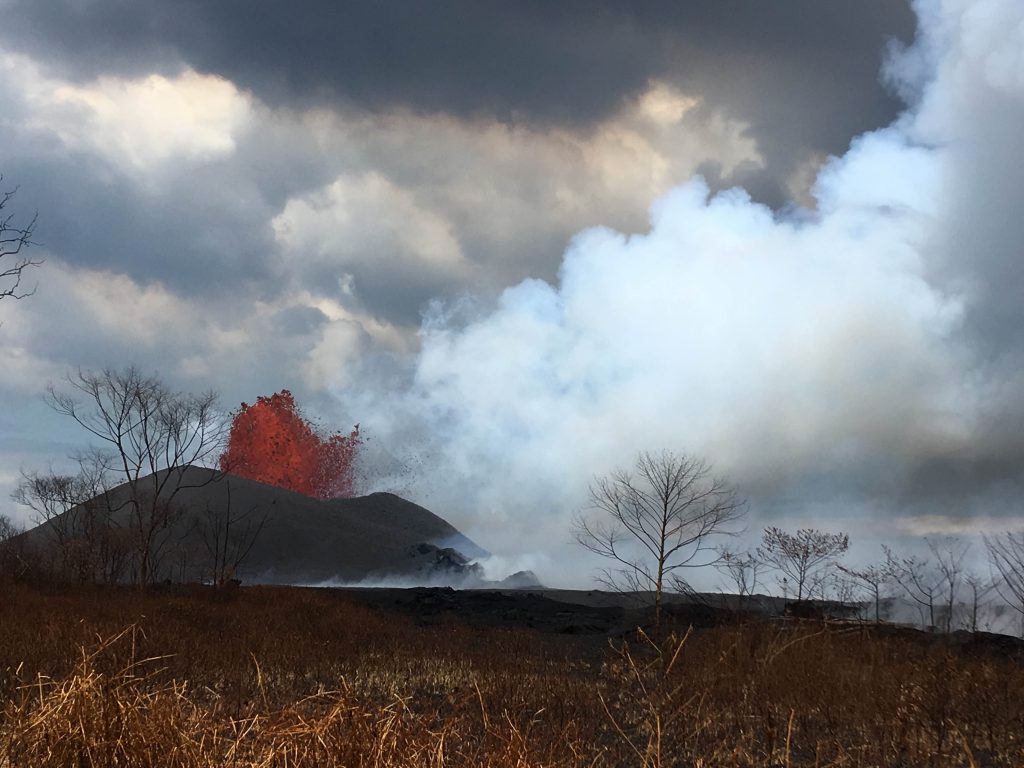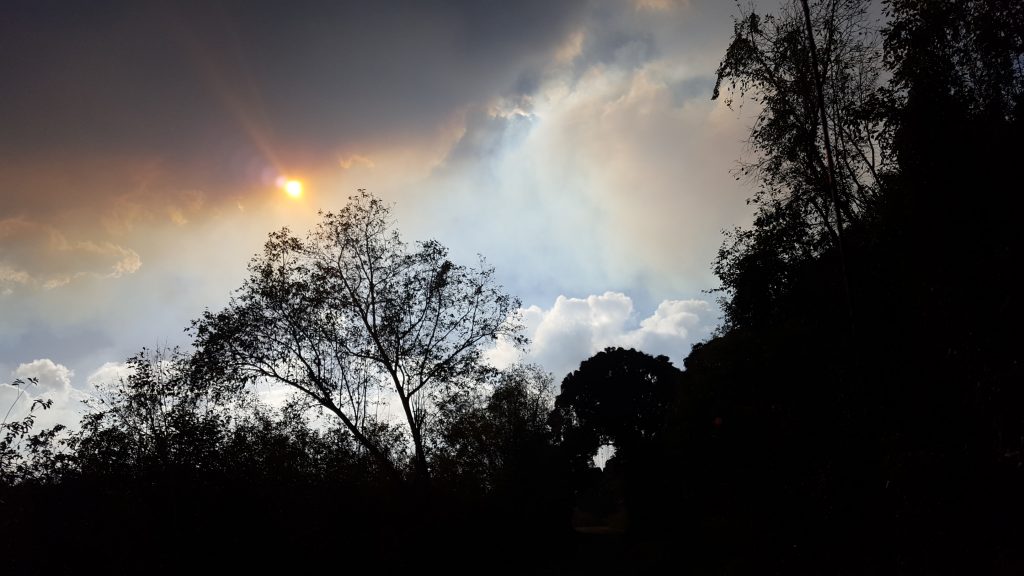HVO Volcano Watch: Can We See Volcanic Gases?

LERZ Fissure 8 on June 5, 2018: The sun is behind the observer taking this photo, making the plume appear bluish due to sunlight scattering by tiny sulfate aerosols. The gas plume is against a very dark cloud background, so that no backlighting is affecting the plume view. PC: Allan Lerner, USGS volunteer

A volcanic gas cloud over the LERZ on May 19, 2018: In this photo, the sun is illuminating the volcanic gas plume from behind. The plume appears orange in color, as the blue component of the sunlight has been preferentially removed by scattering on tiny sulfate aerosols. This looks a bit like a sunset, but note that the meteorological clouds below the volcanic plume do not show this discoloration. PC: Christoph Kern, USGS
Colorful plumes—can we see volcanic gases?
When volcanic gases are released into the atmosphere, resulting plumes sometimes appear to have a faint color. Is this color indicative of a certain gas present? Answering this question requires describing what makes a plume visible in the first place.
High temperature volcanic gases consist mostly of water vapor. In fact, more than 90% of the emitted gas is just steam. And so, gas plumes are often whitish due to sunlight being scattered on water droplets condensing within the plume as it cools. This process is similar to condensation in meteorological clouds. Thus, volcanic plumes are often hard to distinguish from simple water clouds. It also explains why the temperature and humidity of the background atmosphere has significant control over the visibility of a volcanic plume. Volcanic gases emitted into cooler, wetter air will condense more efficiently and degassing may appear more vigorous than during warmer, dryer conditions, even if the gas emission rate remains constant. This makes visual assessment of degassing intensity difficult.
On occasion, volcanic plumes appear slightly off-white and at other times they have a faint blue tinge. Other plumes look yellow or brown when compared to nearby water clouds. So are these the different volcanic gases that we are seeing?
The short answer is no. All gases emitted by volcanoes are completely invisible to humans in the concentrations at which they are present. Water is only visible once it condenses, not in the form of water vapor. So what causes these colorful plumes?
The key to this mystery again lies in the scattering of light within the plumes. Steam plumes appear white because water droplets are highly reflective. These droplets are also much larger than the wavelengths of visible light and therefore scatter all visible light with approximately the same efficiency, thus leading to a white color.
ADVERTISEMENT
ad_queue.push(“14||28||49”);
ad_queue.push(“14||28||50”);
ad_queue.push(“14||28||75”);
var mobile_text_ad_hide = function(){ if(jQuery(window).width() > 600) { jQuery(“.mobile_text_ads”).hide(); } }; jquery_queue.push(“mobile_text_ad_hide();”);
Besides water vapor, some volcanic plumes also contain significant amounts of sulfur dioxide. Exposure to these plumes is uncomfortable and can be hazardous, as sulfur dioxide is an irritant and reacts to sulfuric acid when in contact with water. This reaction can occur in your eyes or respiratory tract and lead to a burning sensation. Exposure to sulfur dioxide concentrations above 100 parts per million would be an immediate threat to your health and even your life.
ADVERTISEMENT
ad_queue.push(“14||28||49”);
ad_queue.push(“14||28||50”);
ad_queue.push(“14||28||75”);
var mobile_text_ad_hide = function(){ if(jQuery(window).width() > 600) { jQuery(“.mobile_text_ads”).hide(); } }; jquery_queue.push(“mobile_text_ad_hide();”);
But sulfur dioxide has another characteristic. Once emitted, it reacts with atmospheric gases to form sulfate aerosols. Aerosols are tiny solid particles that are quickly coated and then dissolved in water, since there is plenty of that available in the plume. Compared with meteorological clouds, however, the reaction of sulfur dioxide to sulfate creates many more, much smaller particles in volcanic plumes. In fact, these sulfate aerosol particles are so small that they are comparable in size to the wavelengths of visible light (about 400 to 700 nanometers).
It turns out that the scattering process is different for such small particles. These tiny particles will scatter the short wavelengths of blue light (about 400 nm) more efficiently than the longer wavelengths of red light (about 700 nm). If white light enters such a plume, e.g. by pointing a flash light at it or by standing with the sun at your back, then the returning light might have a slight bluish color to it because of this enhanced back-scattering of blue wavelengths.
Some volcanic plumes appear to have an orange color to them, rather than a blue tint. Interestingly, this is caused by the very same effect, just in different illumination geometry. Imagine the sun is behind a volcanic plume containing significant sulfate aerosols. Some of the light entering the plume will be scattered, with blue light preferentially being redirected. Therefore, the blue component will be missing if we observe the light that makes it all the way through the plume, and the plume will appear orange, brown or even slightly red. This phenomenon is observed whenever the plume is back-lit, for example when viewed against the sun or some bright white meteorological clouds in the background.
The bottom line is that we can’t see the volcanic gases themselves, but we can see the effect of light scattering on aerosols formed by reaction of these gases with air. So whenever you see a blue or orange plume, beware that there are tiny particles in it, and think about where these particles may be coming from. If it’s a volcanic plume, then chances are there’s a significant amount of invisible sulfur dioxide there as well, and you should keep clear!
Volcano Activity Updates
On Kīlauea Volcano’s lower East Rift Zone, lava continues to erupt from fissure 8. As of June 17, lava fountains were feeding a well-established channel flowing east toward the ocean entry in the Kapoho Bay area. Residents in the lower Puna District of Hawaiʻi Island should remain informed and heed Hawaiʻi County Civil Defense closures, warnings, and messages (http://www.hawaiicounty.gov/active-alerts). At Kīlauea’s summit, a subsurface explosion occurred at 6:26 a.m. HST but the resulting gas plume was brief and nearly devoid of ash. Inward slumping of the rim and walls of Halemaʻumaʻu continues in response to ongoing subsidence at the summit.
Mauna Loa is not erupting. Rates of deformation and seismicity have not changed significantly over the past week. The number of monthly and weekly earthquakes recorded beneath the volcano has decreased to near background levels.
One hundred and eighty-four earthquakes were reported felt in Hawai‘i during the past week.
Volcano Watch is a weekly article and activity update written by U.S. Geological Survey`s Hawaiian Volcano Observatory scientists and colleagues.






